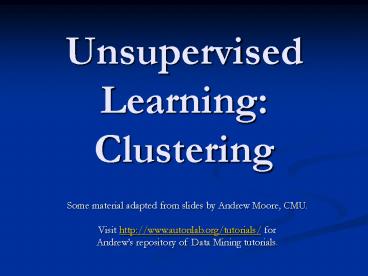Unsupervised Learning: Clustering - PowerPoint PPT Presentation
Title:
Unsupervised Learning: Clustering
Description:
Unsupervised Learning Supervised learning used ... No labels = unsupervised learning Only some points are labeled = semi-supervised learning Labels may be ... – PowerPoint PPT presentation
Number of Views:71
Avg rating:3.0/5.0
Title: Unsupervised Learning: Clustering
1
Unsupervised Learning Clustering
Some material adapted from slides by Andrew
Moore, CMU. Visit http//www.autonlab.org/tutoria
ls/ for Andrews repository of Data Mining
tutorials.
2
Unsupervised Learning
- Supervised learning used labeled data pairs (x,
y) to learn a function f X?Y. - But, what if we dont have labels?
- No labels unsupervised learning
- Only some points are labeled semi-supervised
learning - Labels may be expensive to obtain, so we only get
a few. - Clustering is the unsupervised grouping of data
points. It can be used for knowledge discovery.
3
Clustering Data
4
K-Means Clustering
- K-Means ( k , data )
- Randomly choose k cluster center locations
(centroids). - Loop until convergence
- Assign each point to the cluster of the closest
centroid. - Reestimate the cluster centroids based on the
data assigned to each.
5
K-Means Clustering
- K-Means ( k , data )
- Randomly choose k cluster center locations
(centroids). - Loop until convergence
- Assign each point to the cluster of the closest
centroid. - Reestimate the cluster centroids based on the
data assigned to each.
6
K-Means Clustering
- K-Means ( k , data )
- Randomly choose k cluster center locations
(centroids). - Loop until convergence
- Assign each point to the cluster of the closest
centroid. - Reestimate the cluster centroids based on the
data assigned to each.
7
K-Means Animation
Example generated by Andrew Moore using Dan
Pellegs super-duper fast K-means system Dan
Pelleg and Andrew Moore. Accelerating Exact
k-means Algorithms with Geometric
Reasoning. Proc. Conference on Knowledge
Discovery in Databases 1999.
8
Problems with K-Means
- Very sensitive to the initial points.
- Do many runs of k-Means, each with different
initial centroids. - Seed the centroids using a better method than
random. (e.g. Farthest-first sampling) - Must manually choose k.
- Learn the optimal k for the clustering. (Note
that this requires a performance measure.)
9
Problems with K-Means
- How do you tell it which clustering you want?
- Constrained clustering techniques
10
Learning Bayes Nets
Some material adapted from lecture notes by Lise
Getoor and Ron Parr
Adapted from slides by Tim Finin and Marie
desJardins.
11
Learning Bayesian networks
- Given training set
- Find B that best matches D
- model selection
- parameter estimation
Inducer
Data D
12
Parameter estimation
- Assume known structure
- Goal estimate BN parameters q
- entries in local probability models, P(X
Parents(X)) - A parameterization q is good if it is likely to
generate the observed data - Maximum Likelihood Estimation (MLE) Principle
Choose q so as to maximize L
i.i.d. samples
13
Parameter estimation II
- The likelihood decomposes according to the
structure of the network - ? we get a separate estimation task for each
parameter - The MLE (maximum likelihood estimate) solution
- for each value x of a node X
- and each instantiation u of Parents(X)
- Just need to collect the counts for every
combination of parents and children observed in
the data - MLE is equivalent to an assumption of a uniform
prior over parameter values
sufficient statistics
14
Sufficient statistics Example
- Why are the counts sufficient?
Moon-phase
Light-level
Earthquake
Burglary
Alarm
?A E, B N(A, E, B) / N(E, B)
15
Model selection
- Goal Select the best network structure, given
the data - Input
- Training data
- Scoring function
- Output
- A network that maximizes the score
16
Structure selection Scoring
- Bayesian prior over parameters and structure
- get balance between model complexity and fit to
data as a byproduct - Score (GD) log P(GD) ? log P(DG) P(G)
- Marginal likelihood just comes from our parameter
estimates - Prior on structure can be any measure we want
typically a function of the network complexity
Marginal likelihood
Prior
17
Heuristic search
18
Exploiting decomposability
19
Variations on a theme
- Known structure, fully observable only need to
do parameter estimation - Unknown structure, fully observable do heuristic
search through structure space, then parameter
estimation - Known structure, missing values use expectation
maximization (EM) to estimate parameters - Known structure, hidden variables apply adaptive
probabilistic network (APN) techniques - Unknown structure, hidden variables too hard to
solve!
20
Handling missing data
- Suppose that in some cases, we observe
earthquake, alarm, light-level, and moon-phase,
but not burglary - Should we throw that data away??
- Idea Guess the missing valuesbased on the other
data
Moon-phase
Light-level
Earthquake
Burglary
Alarm
21
EM (expectation maximization)
- Guess probabilities for nodes with missing values
(e.g., based on other observations) - Compute the probability distribution over the
missing values, given our guess - Update the probabilities based on the guessed
values - Repeat until convergence
22
EM example
- Suppose we have observed Earthquake and Alarm but
not Burglary for an observation on November 27 - We estimate the CPTs based on the rest of the
data - We then estimate P(Burglary) for November 27 from
those CPTs - Now we recompute the CPTs as if that estimated
value had been observed - Repeat until convergence!
Earthquake
Burglary
Alarm































